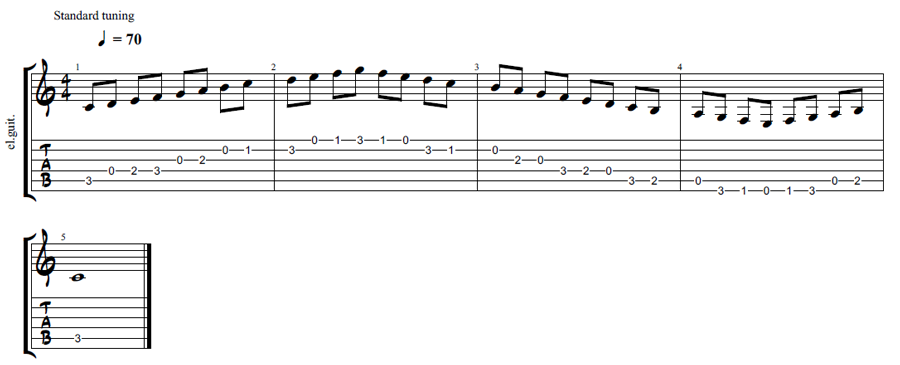Open Major Guitar Scales
Exercises To Master Major Scales in Open Position
The major scale is the most important type of scale; from it, we can derive other forms such as pentatonic and modal scales. In this tutorial, we're going to learn major scales in open positions.
Playing scales in open positions is quite easy, as these fingerings do not require big stretches; this is possible because they use open strings, on which you don't have to press any fret.
Unlike other scale forms such as 4-frets-boxes or 3-notes-strings, open scales are not movable, you can't shift them up or down the neck to play in another key (you can do this only by using a capo).
For this reason, in this post, we'll learn 7 different open major scales for the keys of C, D, E, F, G, A and B, introducing sharps and flats as required by the key.
Open scales have a richer and bigger sound, and they are used a lot in rock and country.
So let's get started
Open Major Scales on Guitar
The following fingerings use the major scale formula, W-W-H-W-W-W-H (whole step, whole step, half step, whole step, whole step, half step) starting from each root:
Open C Major Scale
The C Major scale does not have any sharp or flat.

Open G Major Scale
In the G major scale we have an F#.

Open D Major Scale
F# and C# are needed to build the D major scale.

Open A Major Scale
The A major scale has C#, F# and G#.

Open E Major Scale
In the E major scale we find F#, G#, C# and D#.

Open B Major Scale
The B major scale has sharps on C#, D#, F#, G# and A#

Open F Major Scale
To build a F major scale, we need a flat on B, so here we have a Bb.

Maybe you are wondering why these major scales are listed in this particular order (C, G, D, A, E, B, F). This sorting is derived from the Circle of Fifths, in which keys are shown by adding one sharp or flat at a time (C has no flats/sharps, G has 1 sharps, D has 2 sharps, A 3 sharps and so on).
Tips On How To Practice These Scales
Ok, now that we know the fingerings for open major scales, here are some tips to practice them in the most effective way:
- Always begin the scale from the tonic (1), go up to the higher E string, and then go down to the lower E string.
- Set the metronome to 70 bpm and play the scale in octave (1/8) and triplets
- All these fingerings should be memorized as second nature.
- Once you have the fingerings under your belt, you could also apply more complex exercises.
C Open Major Guitar Scale Tab
Here below you find the guitar tab for playing these open major scale patterns (the examples are based on the key of C):

C Open Major Guitar Scale in Triplets Tab

Open Major Scales - Conclusions
Ok, now you have something to work on. Be sure to internalize all these fingerings, they will come in handy in a variety of situations.
The major scale is the foundation of music theory, from it you can derive basically any other theory concept.
Want to build chords? Start with the major scale and pick notes in thirds. Want to play arpeggios? Same as above, but play one note at a time.
Want to play a mixolydian scale? All you have to do is to start from your major scale, and lower the 7th degree by one flat (in the key of C, B will become Bb).
Those are more advanced concepts that we will tackle in future lessons, for this tutorial be sure to memorize all these open major scale fingerings.
To stay updated and access the free downloads, subscribe here.